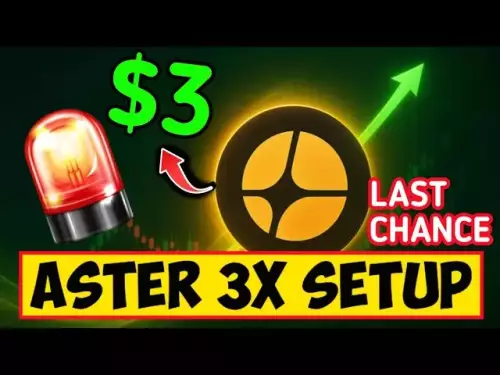-
 bitcoin
bitcoin $106975.071866 USD
-0.29% -
 ethereum
ethereum $3871.670850 USD
-0.07% -
 tether
tether $1.000261 USD
-0.01% -
 bnb
bnb $1084.417621 USD
-0.50% -
 xrp
xrp $2.348167 USD
0.82% -
 solana
solana $185.621736 USD
0.45% -
 usd-coin
usd-coin $0.999833 USD
-0.04% -
 tron
tron $0.313423 USD
0.81% -
 dogecoin
dogecoin $0.188856 USD
0.54% -
 cardano
cardano $0.630416 USD
-0.49% -
 hyperliquid
hyperliquid $36.506353 USD
2.24% -
 ethena-usde
ethena-usde $0.999584 USD
-0.01% -
 chainlink
chainlink $16.750026 USD
-0.77% -
 stellar
stellar $0.313373 USD
0.37% -
 bitcoin-cash
bitcoin-cash $465.978560 USD
-1.57%
How to use technical analysis to predict the price trend of Flare(FLR)? What are the commonly used indicators?
Technical analysis helps predict Flare (FLR) price trends by analyzing historical data, identifying patterns, and using indicators like Moving Averages and RSI.
May 06, 2025 at 05:07 pm

Technical analysis is a crucial tool for traders and investors looking to predict the price trends of cryptocurrencies like Flare (FLR). By analyzing historical price data and market statistics, technical analysis helps in making informed decisions about buying, selling, or holding a cryptocurrency. In this article, we will explore how to use technical analysis to predict the price trend of Flare (FLR) and discuss some commonly used indicators.
Understanding Technical Analysis
Technical analysis is the study of past market data, primarily price and volume, to forecast future price movements. This method relies on the belief that historical price movements can indicate future trends. For Flare (FLR), traders use various charts and indicators to analyze price patterns and make predictions.
The process of technical analysis involves several steps, including identifying trends, recognizing patterns, and using indicators to confirm signals. It's essential to understand that while technical analysis can be a powerful tool, it is not foolproof and should be used in conjunction with other forms of analysis, such as fundamental analysis.
Identifying Trends in Flare (FLR)
The first step in using technical analysis to predict the price trend of Flare (FLR) is to identify the overall trend. Trends can be classified as uptrends, downtrends, or sideways trends. An uptrend is characterized by higher highs and higher lows, indicating a bullish market. Conversely, a downtrend shows lower highs and lower lows, signaling a bearish market. A sideways trend, also known as a range-bound market, occurs when the price moves within a relatively stable range.
To identify trends in Flare (FLR), traders often use trend lines. A trend line is drawn by connecting two or more price points on a chart. For an uptrend, the line is drawn along the lows of the price action, while for a downtrend, it is drawn along the highs. If the price consistently respects the trend line, it can be used to predict future price movements.
Recognizing Patterns in Flare (FLR)
In addition to identifying trends, recognizing patterns is another crucial aspect of technical analysis. Patterns can provide insights into potential future price movements. Some common patterns that traders look for in Flare (FLR) include head and shoulders, double tops and bottoms, and triangles.
- Head and Shoulders: This pattern consists of three peaks, with the middle peak (the head) being the highest and the two outer peaks (the shoulders) being lower. A head and shoulders pattern can signal a reversal from an uptrend to a downtrend.
- Double Tops and Bottoms: These patterns occur when the price reaches a high or low twice, failing to break through the previous high or low. A double top can indicate a bearish reversal, while a double bottom can signal a bullish reversal.
- Triangles: Triangles are formed when the price converges towards a single point, creating a triangle shape on the chart. There are three types of triangles: ascending, descending, and symmetrical. Ascending triangles can signal a bullish breakout, descending triangles can indicate a bearish breakout, and symmetrical triangles can signal a breakout in either direction.
Using Indicators to Predict Flare (FLR) Price Trends
Indicators are mathematical calculations based on the price and/or volume of a cryptocurrency. They are used to confirm trends, identify potential reversals, and generate buy or sell signals. Some commonly used indicators for predicting the price trend of Flare (FLR) include Moving Averages, Relative Strength Index (RSI), and Bollinger Bands.
- Moving Averages: Moving averages smooth out price data to create a single flowing line, making it easier to identify the direction of the trend. The two most commonly used moving averages are the Simple Moving Average (SMA) and the Exponential Moving Average (EMA). When the price of Flare (FLR) is above the moving average, it can indicate an uptrend, and when it is below, it can signal a downtrend.
- Relative Strength Index (RSI): The RSI is a momentum oscillator that measures the speed and change of price movements. It ranges from 0 to 100 and is typically used to identify overbought or oversold conditions. An RSI above 70 can indicate that Flare (FLR) is overbought, while an RSI below 30 can signal that it is oversold.
- Bollinger Bands: Bollinger Bands consist of a middle band (usually a 20-day SMA) and two outer bands that are standard deviations away from the middle band. When the price of Flare (FLR) touches the upper band, it can indicate that the cryptocurrency is overbought, and when it touches the lower band, it can signal that it is oversold. Bollinger Bands can also be used to identify periods of high or low volatility.
Applying Technical Analysis to Flare (FLR)
To apply technical analysis to predict the price trend of Flare (FLR), traders can follow these steps:
- Choose a Timeframe: Decide on the timeframe for your analysis, whether it's short-term (e.g., 15-minute or hourly charts) or long-term (e.g., daily or weekly charts). Different timeframes can provide different insights into the price trend.
- Analyze the Chart: Use a charting platform to plot the price of Flare (FLR) over the chosen timeframe. Look for trends and patterns, such as trend lines, head and shoulders, double tops and bottoms, and triangles.
- Apply Indicators: Add indicators like moving averages, RSI, and Bollinger Bands to the chart. Use these indicators to confirm the trends and patterns you have identified.
- Make a Prediction: Based on your analysis, make a prediction about the future price trend of Flare (FLR). For example, if you identify an uptrend and the RSI is not overbought, you might predict that the price will continue to rise.
Common Mistakes to Avoid
While technical analysis can be a powerful tool for predicting the price trend of Flare (FLR), there are some common mistakes that traders should avoid:
- Over-reliance on Indicators: While indicators can provide valuable insights, they should not be the sole basis for making trading decisions. Always consider the broader market context and other forms of analysis.
- Ignoring Risk Management: Technical analysis can help predict price trends, but it cannot eliminate risk. Always use proper risk management techniques, such as setting stop-loss orders and managing position sizes.
- Chasing Past Performance: Just because a pattern or indicator worked in the past does not guarantee it will work in the future. Always consider the current market conditions and adapt your analysis accordingly.
Frequently Asked Questions
Q: Can technical analysis be used to predict the price trend of Flare (FLR) with 100% accuracy?A: No, technical analysis cannot predict the price trend of Flare (FLR) with 100% accuracy. It is a tool that can provide insights and increase the probability of making successful trades, but it is not foolproof. Always use technical analysis in conjunction with other forms of analysis and proper risk management.
Q: How often should I update my technical analysis for Flare (FLR)?A: The frequency of updating your technical analysis for Flare (FLR) depends on your trading strategy and timeframe. For short-term traders, daily or even hourly updates may be necessary. For long-term investors, weekly or monthly updates might be sufficient. Always stay informed about market conditions and adjust your analysis as needed.
Q: Are there any specific technical analysis tools recommended for Flare (FLR)?A: While there are no specific tools recommended exclusively for Flare (FLR), popular charting platforms like TradingView, MetaTrader, and Coinigy can be used to perform technical analysis on Flare (FLR). These platforms offer a wide range of indicators and drawing tools that can help you analyze the price trend of Flare (FLR).
Q: How can I combine technical analysis with fundamental analysis for Flare (FLR)?A: Combining technical analysis with fundamental analysis for Flare (FLR) involves using both methods to make more informed trading decisions. Technical analysis can help you identify short-term price trends and entry/exit points, while fundamental analysis can provide insights into the long-term value and potential of Flare (FLR). For example, if technical analysis indicates a bullish trend and fundamental analysis shows strong project fundamentals, it might be a good time to buy Flare (FLR).
Disclaimer:info@kdj.com
The information provided is not trading advice. kdj.com does not assume any responsibility for any investments made based on the information provided in this article. Cryptocurrencies are highly volatile and it is highly recommended that you invest with caution after thorough research!
If you believe that the content used on this website infringes your copyright, please contact us immediately (info@kdj.com) and we will delete it promptly.
- Pi Network's Web3 Evolution: AI, Blockchain, and a $100 Vision
- 2025-10-19 22:25:13
- OpenSea's Bold Move: From NFT Marketplace to Trading Platform Giant – A Token Launch on the Horizon?
- 2025-10-19 22:25:13
- Pi Network: Is the Undervalued Crypto Finally Getting the Attention It Deserves?
- 2025-10-19 22:30:14
- Crypto Presales & AI: DeepSnitch AI Leading the Charge for Safer Projects
- 2025-10-19 22:30:14
- Hyperliquid: Dismissing Profit Rumors and Prioritizing Risk Control in the DeFi Arena
- 2025-10-19 20:45:14
- AI-Powered Crypto Gems: Unearthing the Next Big Coins
- 2025-10-19 20:25:12
Related knowledge

Practical parameter settings for a Bitcoin multi-timeframe moving average system
Sep 18,2025 at 10:54pm
Optimizing Timeframe Combinations for Bitcoin Trading1. Selecting appropriate timeframes is crucial when building a multi-timeframe moving average sys...

How can I filter out false breakouts in Dogecoin high-frequency trading?
Sep 22,2025 at 01:00am
Understanding False Breakouts in Dogecoin Trading1. A false breakout occurs when Dogecoin's price appears to move beyond a defined support or resistan...

Techniques for identifying tops and bottoms in the Bitcoin on-chain NVT model
Sep 20,2025 at 07:54pm
Understanding the NVT Model in Bitcoin Analysis1. The Network Value to Transactions (NVT) ratio is often described as the 'P/E ratio' of the cryptocur...

What does the surge in open interest in Bitcoincoin futures mean?
Sep 20,2025 at 11:18pm
Understanding the Surge in Dogecoin Futures Open Interest1. A surge in open interest within Dogecoin futures indicates a growing number of active cont...

How can I use the Ethereum USDT premium to gauge market sentiment?
Sep 18,2025 at 11:55pm
Understanding the Ethereum USDT Premium1. The Ethereum USDT premium refers to the price difference between USDT (Tether) traded on Ethereum-based plat...

What should I do if Ethereum staking yields decline?
Sep 20,2025 at 06:18am
Understanding the Causes Behind Declining Ethereum Staking Yields1. The Ethereum network transitioned to a proof-of-stake consensus mechanism with the...

Practical parameter settings for a Bitcoin multi-timeframe moving average system
Sep 18,2025 at 10:54pm
Optimizing Timeframe Combinations for Bitcoin Trading1. Selecting appropriate timeframes is crucial when building a multi-timeframe moving average sys...

How can I filter out false breakouts in Dogecoin high-frequency trading?
Sep 22,2025 at 01:00am
Understanding False Breakouts in Dogecoin Trading1. A false breakout occurs when Dogecoin's price appears to move beyond a defined support or resistan...

Techniques for identifying tops and bottoms in the Bitcoin on-chain NVT model
Sep 20,2025 at 07:54pm
Understanding the NVT Model in Bitcoin Analysis1. The Network Value to Transactions (NVT) ratio is often described as the 'P/E ratio' of the cryptocur...

What does the surge in open interest in Bitcoincoin futures mean?
Sep 20,2025 at 11:18pm
Understanding the Surge in Dogecoin Futures Open Interest1. A surge in open interest within Dogecoin futures indicates a growing number of active cont...

How can I use the Ethereum USDT premium to gauge market sentiment?
Sep 18,2025 at 11:55pm
Understanding the Ethereum USDT Premium1. The Ethereum USDT premium refers to the price difference between USDT (Tether) traded on Ethereum-based plat...

What should I do if Ethereum staking yields decline?
Sep 20,2025 at 06:18am
Understanding the Causes Behind Declining Ethereum Staking Yields1. The Ethereum network transitioned to a proof-of-stake consensus mechanism with the...
See all articles










































































